Themed collection Machine Learning and Artificial Intelligence: A cross-journal collection

Machine learning integrated photocatalysis: progress and challenges
By integrating machine learning with automation and robots, accelerated discovery of photocatalysts in the future could be envisioned.

Chem. Commun., 2023,59, 5795-5806
https://doi.org/10.1039/D3CC00989K
Modern machine learning for tackling inverse problems in chemistry: molecular design to realization
Many of the tasks in the molecular design pipeline can be modelled as inverse problems. This highlight focuses on recent developments in modern machine learning methods which can be used to tackle those inverse problems.

Chem. Commun., 2022,58, 5316-5331
https://doi.org/10.1039/D1CC07035E
Neural network potentials for chemistry: concepts, applications and prospects
Artificial Neural Networks (NN) are already heavily involved in methods and applications for frequent tasks in the field of computational chemistry such as representation of potential energy surfaces (PES) and spectroscopic predictions.

Digital Discovery, 2023,2, 28-58
https://doi.org/10.1039/D2DD00102K
A review of recent advances and applications of machine learning in tribology
This review summarises recent advances in the use of machine learning for predicting friction and wear in tribological systems, material discovery, lubricant design and composite formulation. Potential future applications and areas for further research are also discussed.
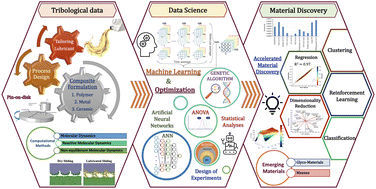
Phys. Chem. Chem. Phys., 2023,25, 4408-4443
https://doi.org/10.1039/D2CP03692D
Machine learning potential era of zeolite simulation
The machine learning atomic simulation will usher the research of zeolite, as other complex materials, into a new era featuring the easy access to zeolite functionalities predicted from theory.

Chem. Sci., 2022,13, 5055-5068
https://doi.org/10.1039/D2SC01225A
Accelerating manufacturing for biomass conversion via integrated process and bench digitalization: a perspective
This article provides a vision on how to accelerate the production of chemicals and fuels from biomass feedstocks using an integrated framework of data mining, retrosynthesis, lab automation, and process systems engineering.
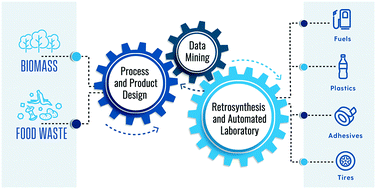
React. Chem. Eng., 2022,7, 813-832
https://doi.org/10.1039/D1RE00560J
High-throughput screening, next generation sequencing and machine learning: advanced methods in enzyme engineering
Enzyme engineering is an important biotechnological process capable of generating tailored biocatalysts for applications in industrial chemical conversion and biopharma.
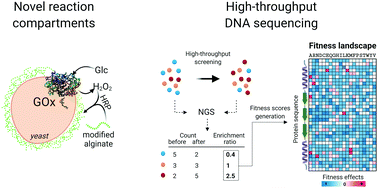
Chem. Commun., 2022,58, 2455-2467
https://doi.org/10.1039/D1CC04635G
Machine learning in energy chemistry: introduction, challenges and perspectives
This review explores machine learning's role in energy chemistry, spanning organic photovoltaics, perovskites, catalysis, and batteries, highlighting its potential to accelerate eco-friendly, sustainable energy development.
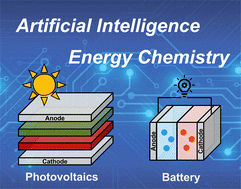
Energy Adv., 2023,2, 896-921
https://doi.org/10.1039/D3YA00057E
Memristor-based neural networks: a bridge from device to artificial intelligence
This paper reviews the research progress in memristor-based neural networks and puts forward future development trends.

Nanoscale Horiz., 2023,8, 716-745
https://doi.org/10.1039/D2NH00536K
Machine learning-inspired battery material innovation
Data-driven machine learning is a proven technique for battery material discovery and enables the development of sustainable next-generation batteries.

Energy Adv., 2023,2, 449-464
https://doi.org/10.1039/D3YA00040K
Data-driven design of electrocatalysts: principle, progress, and perspective
In this review, we focus on the systematic construction of the data-driven electrocatalyst design framework and discuss its principles, current challenges, and opportunities.

J. Mater. Chem. A, 2023,11, 3849-3870
https://doi.org/10.1039/D2TA09278F
How machine learning can accelerate electrocatalysis discovery and optimization
Machine learning can accelerate the process of electrocatalyst discovery and optimization, especially when incorporated into a closed-loop approach with autonomous laboratories. This review highlights the recent progress and challenges in this field.
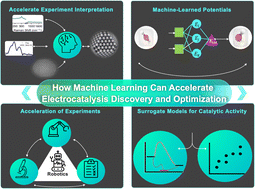
Mater. Horiz., 2023,10, 393-406
https://doi.org/10.1039/D2MH01279K
Predictive chemistry: machine learning for reaction deployment, reaction development, and reaction discovery
This review outlines several organic chemistry tasks for which predictive machine learning models have been and can be applied.
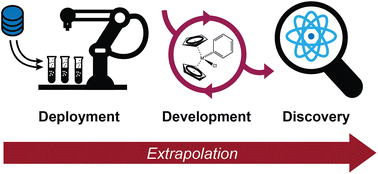
Chem. Sci., 2023,14, 226-244
https://doi.org/10.1039/D2SC05089G
Machine learning in electron microscopy for advanced nanocharacterization: current developments, available tools and future outlook
The cross-fertilisation between the listed disciplines with a long standing knowledge on the application of artificial intelligence protocols and electron microscopy for materials science can entail the next breakthroughs in the field.

Nanoscale Horiz., 2022,7, 1427-1477
https://doi.org/10.1039/D2NH00377E
Quantum machine learning for chemistry and physics
Quantum variants of machine learning algorithms are discussed with emphasis on methodology, learning techniques and applications in broad and distinct domains of chemical physics.

Chem. Soc. Rev., 2022,51, 6475-6573
https://doi.org/10.1039/D2CS00203E
Industrial data science – a review of machine learning applications for chemical and process industries
Understand and optimize industrial processes via machine learning and chemical engineering principles.
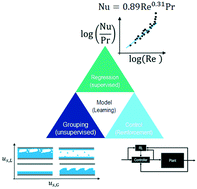
React. Chem. Eng., 2022,7, 1471-1509
https://doi.org/10.1039/D1RE00541C
Recent trends in computational tools and data-driven modeling for advanced materials
The paradigm of advanced materials has grown exponentially over the last decade, with their new dimensions including digital design, dynamics, and functions.
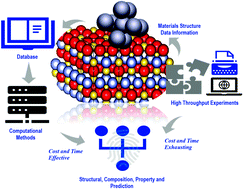
Mater. Adv., 2022,3, 4069-4087
https://doi.org/10.1039/D2MA00067A
Intelligent control of nanoparticle synthesis through machine learning
Machine learning-assisted synthesis of nanoparticles.

Nanoscale, 2022,14, 6688-6708
https://doi.org/10.1039/D2NR00124A
Emerging cold plasma treatment and machine learning prospects for seed priming: a step towards sustainable food production
The perspective of machine learning for modeling plasma treatment parameters in agriculture for the development of synergistic protocols for different types of seed priming.
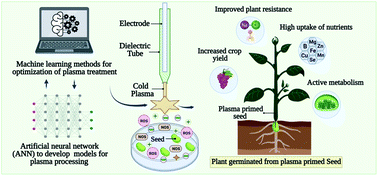
RSC Adv., 2022,12, 10467-10488
https://doi.org/10.1039/D2RA00809B
Understanding, discovery, and synthesis of 2D materials enabled by machine learning
Machine learning (ML) is becoming an effective tool for studying 2D materials.
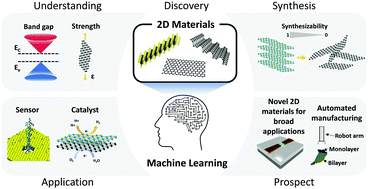
Chem. Soc. Rev., 2022,51, 1899-1925
https://doi.org/10.1039/D1CS00503K
Recent developments of e-sensing devices coupled to data processing techniques in food quality evaluation: a critical review
Within the agri-food sector, e-noses, e-tongues, and e-eyes generate interest. This review delves into their principles, challenges, and data processing methods, featuring case studies that contribute to the advancement of e-sensing technologies.

Anal. Methods, 2023,15, 5410-5440
https://doi.org/10.1039/D3AY01132A
Machine learning for algal biofuels: a critical review and perspective for the future
Machine learning applications in microalgae biofuel production are reviewed; the current states and major trends in research as well as the challenges to overcome are identified.
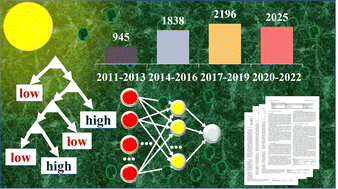
Green Chem., 2023,25, 3354-3373
https://doi.org/10.1039/D3GC00389B
Machine learning for microfluidic design and control
In this review article, we surveyed the applications of machine learning in microfluidic design and microfluidic control.

Lab Chip, 2022,22, 2925-2937
https://doi.org/10.1039/D2LC00254J
Discovery of all-inorganic lead-free perovskites with high photovoltaic performance via ensemble machine learning
A multi-step and multi-stage high-throughput materials search via ensemble machine learning is developed to carefully and comprehensively screen nearly 12 million  all-inorganic perovskites with potential high photovoltaic performance.
all-inorganic perovskites with potential high photovoltaic performance.

Mater. Horiz., 2023,10, 5288-5297
https://doi.org/10.1039/D3MH00967J
Predicting and analyzing organic reaction pathways by combining machine learning and reaction network approaches
By training 50 fundamental organic reactions, the learning model predicted the products and pathways of 35 test reactions. The model identified the key fragment structures of the reaction intermediates.

Chem. Commun., 2023,59, 12439-12442
https://doi.org/10.1039/D3CC03890D
Improved environmental chemistry property prediction of molecules with graph machine learning
Rapid prediction of environmental chemistry properties is critical for the green and sustainable development of the chemical industry and drug discovery.

Green Chem., 2023,25, 6612-6617
https://doi.org/10.1039/D3GC01920A
Learning molecular dynamics: predicting the dynamics of glasses by a machine learning simulator
A graph-based machine learning model is built to predict atom dynamics from their static structure, which, in turn, unveils the predictive power of static structure in dynamical evolution of disordered phases.
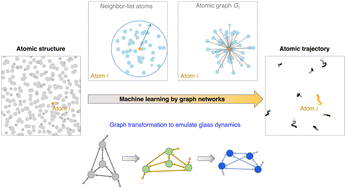
Mater. Horiz., 2023,10, 3416-3428
https://doi.org/10.1039/D3MH00028A
Incorporating plasmonic featurization with machine learning to achieve accurate and bidirectional prediction of nanoparticle size and size distribution
Schematic of our bidirectional, ML-empowered approach incorporating plasmonic featurization for rapid (<30 s) and accurate determination of the size and size distribution of gold nanosphere (Au NSs) ensembles in real samples.
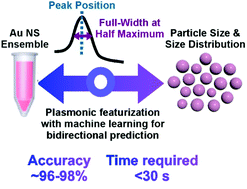
Nanoscale Horiz., 2022,7, 626-633
https://doi.org/10.1039/D2NH00146B
Generative machine learning algorithm for lattice structures with superior mechanical properties
We present a hybrid neural network and genetic optimization adaptive method incorporating Bézier curves to consider the large design space of lattice structures with superior mechanical properties.
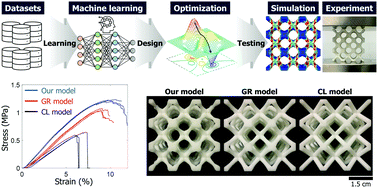
Mater. Horiz., 2022,9, 952-960
https://doi.org/10.1039/D1MH01792F
Fine-tuning GPT-3 for machine learning electronic and functional properties of organic molecules
Fine-tuned GPT-3 shows robust performance for the prediction of electronic and functional properties for organic molecules, with resilience to information loss and noise.
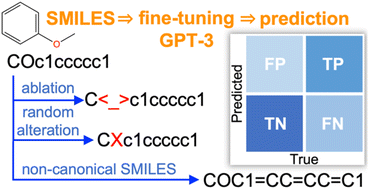
Chem. Sci., 2024,15, 500-510
https://doi.org/10.1039/D3SC04610A
Computationally driven discovery of SARS-CoV-2 Mpro inhibitors: from design to experimental validation
The dominant binding mode of the QUB-00006-Int-07 main protease inhibitor during absolute binding free energy simulations.
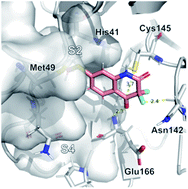
Chem. Sci., 2022,13, 3674-3687
https://doi.org/10.1039/D1SC05892D
Improving machine learning performance on small chemical reaction data with unsupervised contrastive pretraining
Contrastive pretraining of chemical reactions by matching augmented reaction representations to improve machine learning performance on small reaction datasets.

Chem. Sci., 2022,13, 1446-1458
https://doi.org/10.1039/D1SC06515G
A machine learning-enabled process optimization of ultra-fast flow chemistry with multiple reaction metrics
An automated flow chemistry platform was designed to collect data for a lithium-halogen exchange reaction. The data was used to train a Bayesian multi-objective optimization algorithm to optimize the process parameters and build process knowledge.

React. Chem. Eng., 2024,9, 619-629
https://doi.org/10.1039/D3RE00539A
Discrimination of mycoplasma infection using machine learning models trained on autofluorescence signatures of host cells
Cellular autofluorescence signatures, considered to represent the physiological state of individual cells, allow us to discriminate mycoplasma infection using machine learning models.

Sens. Diagn., 2024,3, 287-294
https://doi.org/10.1039/D3SD00175J
Modelling and predicting liquid chromatography retention time for PFAS with no-code machine learning
Machine learning is increasingly popular and promising in environmental science due to its potential in solving various environmental problems, particularly with simple code-free tools.

Environ. Sci.: Adv., 2024,3, 198-207
https://doi.org/10.1039/D3VA00242J
Classification of chemically modified red blood cells in microflow using machine learning video analysis
We classify native and chemically modified RBCs with an AI based video classifier at high accuracy (>90%). We use chemicals to mimic aspects of typical RBC disorders. This enables a label-free categorization, based on cell shape and flow dynamics.

Soft Matter, 2024,20, 952-958
https://doi.org/10.1039/D3SM01337E
Semi-supervised machine learning approach for reaction stoichiometry and kinetic model identification using spectral data from flow reactors
The semi-supervised machine learning approach is an integrated calibration-free modelling framework for identifying reaction systems from spectral data using minimal prior information and it is validated with experimental data obtained in a micro-reactor.

React. Chem. Eng., 2024,9, 355-368
https://doi.org/10.1039/D3RE00334E
An automated and intelligent microfluidic platform for microalgae detection and monitoring
An automated and intelligent microfluidic platform (AIMP), which offers automated system control, intelligent data analysis, and user interaction was developed to provide a cost-effective and portable solution for detecting and monitoring microalgae.

Lab Chip, 2024,24, 244-253
https://doi.org/10.1039/D3LC00851G
Unlocking the predictive power of quantum-inspired representations for intermolecular properties in machine learning
New MODA descriptor, a quantum-inspired representation enhancing ML predictions of molecular properties. By using a wave-function guess, MODA captures electronic structure intricacies to excel in intermolecular property predictions.

Digital Discovery, 2024,3, 99-112
https://doi.org/10.1039/D3DD00187C
Predicting the pair correlation functions of silicate and borosilicate glasses using machine learning
We report a machine learning method for predicting the atom pair correlation functions of a class of glassy materials.

Phys. Chem. Chem. Phys., 2024,26, 1094-1104
https://doi.org/10.1039/D3CP05136F
Machine learning prediction of self-assembly and analysis of molecular structure dependence on the critical packing parameter
We used machine learning to predict the self-assembly structures of amphiphilic molecules and analyzed the physical factors affecting their morphologies.

Mol. Syst. Des. Eng., 2024,9, 20-28
https://doi.org/10.1039/D3ME00151B
Advancing energy storage through solubility prediction: leveraging the potential of deep learning
Solubility prediction plays a crucial role in energy storage applications, such as redox flow batteries, because it directly affects the efficiency and reliability.

Phys. Chem. Chem. Phys., 2023,25, 31836-31847
https://doi.org/10.1039/D3CP03992G
Predicting power plant emissions using public data and machine learning
We show that combining a variety of public datasets and non-linear machine learning models can predict emissions from electric generating units at good accuracy without any proprietary information.

Environ. Sci.: Adv., 2023,2, 1696-1707
https://doi.org/10.1039/D3VA00191A
Data-driven machine learning prediction of glass transition temperature and the glass-forming ability of metallic glasses
The data-driven machine learning approach has greatly improved the predictive accuracy of Tg and Dmax values. The governing rules for GFA have been successfully established through feature significance analysis.

Nanoscale, 2023,15, 18511-18522
https://doi.org/10.1039/D3NR04380K
Unlocking the performance of ternary metal (hydro)oxide amorphous catalysts via data-driven active-site engineering
A machine-learning methodology was applied to unveil the structure–property relationships of the fabricated ternary Ni, Fe, and Co amorphous oxygen evolution catalyst, showcasing remarkable performance and stability via corrosion engineering.

Energy Environ. Sci., 2023,16, 5065-5075
https://doi.org/10.1039/D3EE01981K
Screening of steam-reforming catalysts using unsupervised machine learning
In this article, a bidirectional clustering model proposed for methanol-reforming catalysts demonstrates excellent mathematical performance and is of significance for the discovery of methanol-reforming catalysts.

Catal. Sci. Technol., 2023,13, 6281-6290
https://doi.org/10.1039/D3CY00754E
Multiplex SERS detection of polycyclic aromatic hydrocarbon (PAH) pollutants in water samples using gold nanostars and machine learning analysis
Polycyclic aromatic hydrocarbons (PAHs) have attracted a lot of environmental concern because of their carcinogenic and mutagenic properties, and the fact they can easily contaminate natural resources such as drinking water and river water.

Analyst, 2023,148, 5105-5116
https://doi.org/10.1039/D3AN00636K
Machine learning predictions of diffusion in bulk and confined ionic liquids using simple descriptors
Ionic liquids have many intriguing properties and widespread applications such as separations and energy storage.

Mol. Syst. Des. Eng., 2023,8, 1257-1274
https://doi.org/10.1039/D3ME00033H
Is AI essential? Examining the need for deep learning in image-activated sorting of Saccharomyces cerevisiae
We experimentally justify the advantages of jumping on the deep learning trend for image-activated budding yeast sorting and validate its applicability towards morphology-based yeast mutant screening.
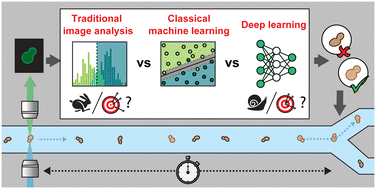
Lab Chip, 2023,23, 4232-4244
https://doi.org/10.1039/D3LC00556A
Machine-learning-aided multiplexed nanoplasmonic biosensor for COVID-19 population immunity profiling
Vaccination and infection rates against variants of COVID-19 in Dane County, WI were determined from low-volume human sera/plasma samples with machine-learning aided nanoplasmonic biosensor. The results agree with the official epidemiological data.

Sens. Diagn., 2023,2, 1186-1198
https://doi.org/10.1039/D3SD00081H
Leveraging machine learning engineering to uncover insights into heterogeneous catalyst design for oxidative coupling of methane
Unveiling current issues in the investigation of highly-active heterogeneous catalysts using machine learning engineering techniques was discussed in the case of oxidative coupling of methane with support vector regression and Bayesian optimization.

Catal. Sci. Technol., 2023,13, 4646-4655
https://doi.org/10.1039/D3CY00596H
A machine learning-based nano-photocatalyst module for accelerating the design of Bi2WO6/MIL-53(Al) nanocomposites with enhanced photocatalytic activity
A machine learning-based nano-photocatalyst module for accelerating the design of Bi2WO6/MIL-53(Al) nanocomposites was constructed by four steps. An online web service was established to quickly predict the photocatalytic activity of Bi2WO6/MIL-53(Al).

Nanoscale Adv., 2023,5, 4065-4073
https://doi.org/10.1039/D3NA00122A
Towards Pareto optimal high entropy hydrides via data-driven materials discovery
Data-driven predictions of metal hydride thermodynamic properties elucidate the Pareto optimal front of high entropy alloy candidates for hydrogen storage.

J. Mater. Chem. A, 2023,11, 15878-15888
https://doi.org/10.1039/D3TA02323K
nanoNET: machine learning platform for predicting nanoparticles distribution in a polymer matrix
We report an ML pipeline that predicts the nanoparticle–nanoparticle pair correlation function of a polymer nanocomposite.

Soft Matter, 2023,19, 5502-5512
https://doi.org/10.1039/D3SM00567D
Leveraging machine learning to consolidate the diversity in experimental results of perovskite solar cells
Application of a machine learning approach to device design. Starting from database analysis followed by a dataset creation based on those insights. Data preprocessing is done to extract features for ML prediction and design new PSCs.

RSC Adv., 2023,13, 22529-22537
https://doi.org/10.1039/D3RA02305B
Machine learning-assisted screening of effective passivation materials for P–I–N type perovskite solar cells
The effective passivation material (ITIC) for P–I–N type perovskite solar cells is selected by machine learning. In the verification experiment, the defect density of the perovskite layer is significantly decreased after treatment with ITIC.

J. Mater. Chem. C, 2023,11, 9602-9610
https://doi.org/10.1039/D3TC01140B
Bayesian machine learning optimization of microneedle design for biological fluid sampling
The deployment of microneedles in biological fluid sampling and drug delivery is an emerging field in biotechnology, which contributes greatly to minimally-invasive methods in medicine.

Sens. Diagn., 2023,2, 858-866
https://doi.org/10.1039/D3SD00103B
Machine learning approaches to the prediction of powder flow behaviour of pharmaceutical materials from physical properties
A Machine Learning (ML) approach was proposed to optimize the manufacturing-route selection from the physical particle properties of a pharmaceutical material.

Digital Discovery, 2023,2, 692-701
https://doi.org/10.1039/D2DD00106C
Development of prediction model for cloud point of thermo-responsive polymers by experiment-oriented materials informatics
A prediction model for cloud point was built by a combination of materials informatics and chemical insight.

Polym. Chem., 2023,14, 2383-2389
https://doi.org/10.1039/D3PY00314K
Accurate prediction of carbon dioxide capture by deep eutectic solvents using quantum chemistry and a neural network
We report the development of machine learning model for the calculation of carbon dioxide solubilities in deep solvent solvents. This model helps to predict and accelerate the development of carbon capture solvents with ideal experimental conditions.

Green Chem., 2023,25, 3475-3492
https://doi.org/10.1039/D2GC04425K
Design of an ultra-broadband terahertz absorber based on a patterned graphene metasurface with machine learning
Utilizes machine learning to propose an absorption bandwidth and structural parameters prediction approach for the design of patterned graphene metasurface absorber, which provides a new direction for the precision design of optical devices.
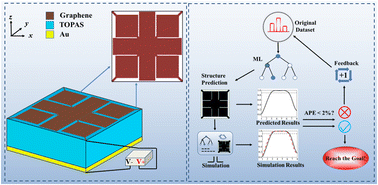
J. Mater. Chem. C, 2023,11, 5625-5633
https://doi.org/10.1039/D3TC00102D
High-throughput computational workflow for ligand discovery in catalysis with the CSD
A novel semi-automated, high-throughput computational workflow for ligand/catalyst discovery based on the Cambridge Structural Database is reported.
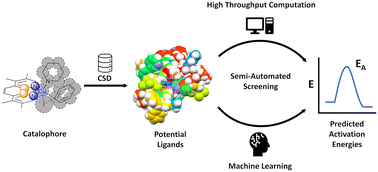
Catal. Sci. Technol., 2023,13, 2407-2420
https://doi.org/10.1039/D3CY00083D
Easy and fast prediction of green solvents for small molecule donor-based organic solar cells through machine learning
A fast machine learning based framework is introduced for the prediction of solubility parameters and selection of green solvents for small molecular donor-based organic solar cells.

Phys. Chem. Chem. Phys., 2023,25, 10417-10426
https://doi.org/10.1039/D3CP00177F
Identification of fluorescently-barcoded nanoparticles using machine learning
We introduce a machine-learning-assisted workflow to write, read, and classify dye-loaded PLGA–PEG nanoparticles at a single-particle level.

Nanoscale Adv., 2023,5, 2307-2317
https://doi.org/10.1039/D2NA00648K
Fusing a machine learning strategy with density functional theory to hasten the discovery of 2D MXene-based catalysts for hydrogen generation
We establish a robust and broadly applicable multistep workflow using machine learning algorithms to construct well-trained data-driven models for predicting the hydrogen evolution reaction activity of 4500 MM′XT2-type MXenes.
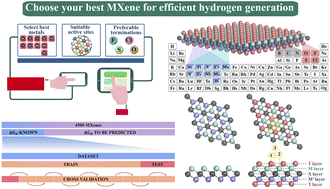
J. Mater. Chem. A, 2023,11, 8091-8100
https://doi.org/10.1039/D3TA00344B
Classical and quantum machine learning applications in spintronics
Prediction of physical observables with machine learning for spintronic and molecular devices.

Digital Discovery, 2023,2, 512-519
https://doi.org/10.1039/D2DD00094F
Rational design of MoS2-supported Cu single-atom catalysts by machine learning potential for enhanced peroxidase-like activity
Machine learning motivated Cu@MoS2 catalysts design for enhanced peroxidase-like activity.

Nanoscale, 2023,15, 6686-6695
https://doi.org/10.1039/D2NR07270J
A Predictive machine-learning model for propagation rate coefficients in radical polymerization
Using ridge regression, the propagation rate coefficients for radical polymerization are correlated with basic molecular properties.

Polym. Chem., 2023,14, 1622-1629
https://doi.org/10.1039/D2PY01531E
Machine learning assisted binary alloy catalyst design for the electroreduction of CO2 to C2 products
CO2RR binary alloy catalyst design insight gained through density functional theory and machine learning with a focus on COCOH adsorption energy.
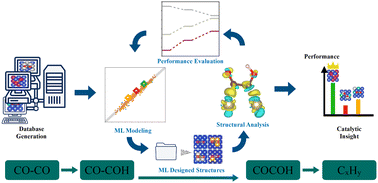
Energy Adv., 2023,2, 410-419
https://doi.org/10.1039/D2YA00316C
Insights into the deviation from piecewise linearity in transition metal complexes from supervised machine learning models
Artificial neural networks trained on 23 density functional approximations (DFAs) from multiple rungs of “Jacob's ladder” enable the prediction of where each DFA has zero curvature for chemical discovery.
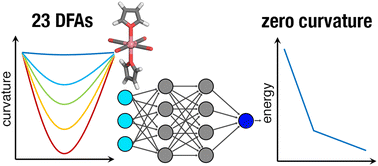
Phys. Chem. Chem. Phys., 2023,25, 8103-8116
https://doi.org/10.1039/D3CP00258F
About this collection
Although relatively new technologies, the rapid development of machine learning (ML) and artificial intelligence (AI) has the potential to revolutionise the way in which we conduct chemistry research.
Demonstrating applications across the chemical sciences, this cross-journal collection highlights recent ML & AI work from across the RSC portfolio. From use in predicting catalyst behaviour, to interpreting analytical data, these papers showcase the cutting edge of this exciting area.